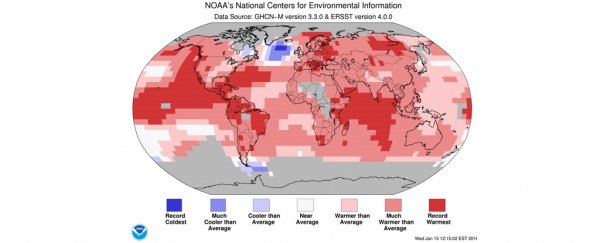Earth's oceans are simmering with the heat trapped by increasing amounts of greenhouse gases. But one patch of water in the North Atlantic is stubbornly resisting the trend, and actually dropping in temperature.
This 'cold blob' has been a subject of interest for climatologists ever since it was first spotted back in 2015. Unfortunately, the complexities of ocean circulation make it a tricky thing to easily explain.
A new study adds detail to the phenomenon, revealing there's more than one cause at work.
A team of researchers from the Max Planck Institute for Meteorology in Germany applied long-term climate modelling to simulate various configurations to find which match the observed plunge in temperature.
One of the factors they identified comes as no real surprise, backing up previous studies that show a current of water called the Atlantic meridional overturning circulation (AMOC) has weakened significantly since the mid-20th century.
When running at full steam, the circulation takes warm, salty surface waters from the tropics near the Gulf of Mexico north towards the European coast, exchanging it for cold, fresh water supplied by melting ice.
Exactly what might be causing this highway of tropical water to slow down isn't all that clear, though some models suggest more meltwater from Greenland coupled with rising global temperatures would fit what we're seeing.
With warmer temperatures making the ocean water more buoyant, it's less likely to drop as quickly, slowing the spiral. Meanwhile, a good dose of fresh water trickling in from melting Arctic ice and higher rainfall would also impede the circulating currents by forming a layer of less salty water on the surface.
Still, data on the AMOC aren't the highest quality prior to 2004, leaving open the small possibility that the slow-down could be a return to business as usual rather than something triggered by a warming planet.
To tease out connections between Earth's climate and the cold blob, the researchers behind this latest study used a detailed planetary climate model to couple variations in energy, carbon dioxide, and water across the ocean, land, and atmosphere.
Simulations run through this model allowed them to see what might happen if they forced the AMOC to churn away at full speed, leaving the atmosphere to act as a major influencing factor all on its own.
Sure enough, there was a small but noticeable effect. As the incoming warm waters cooled down, they produced low-lying clouds that would reflect incoming radiation, in turn cooling the surface even further.
Next, the team ran another scenario that looked only at the AMOC's transport of heat, finding it wasn't just carrying less energy, but was dumping more of it into the Arctic's circulating water currents.
For complicated reasons, these subpolar circulations are picking up speed, drawing heat from the AMOC and leaving the cold blob even colder.
There's still plenty of work to be done on building up these explanations and determining how much of an impact our insatiable desire to burn fossil fuels has had on what would otherwise be a natural cycle.
But the study goes a long way in showing how important it is that we take into account diverse factors in assessing local and global changes to the climate.
No doubt researchers will be paying even closer attention to the AMOC's strength in coming years. But knowing exactly how this cold blob operates in a changing climate will help us better understand what to expect in a future that's likely to be several degrees warmer.
This research was published in Nature Climate Change.
